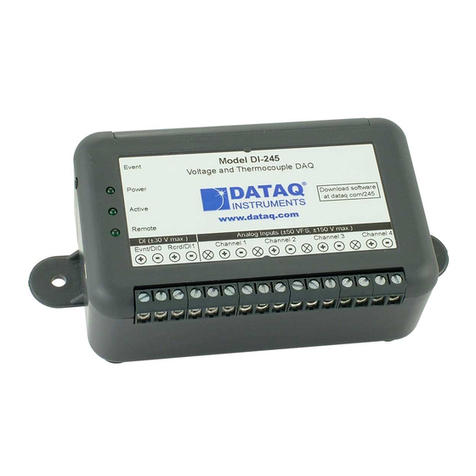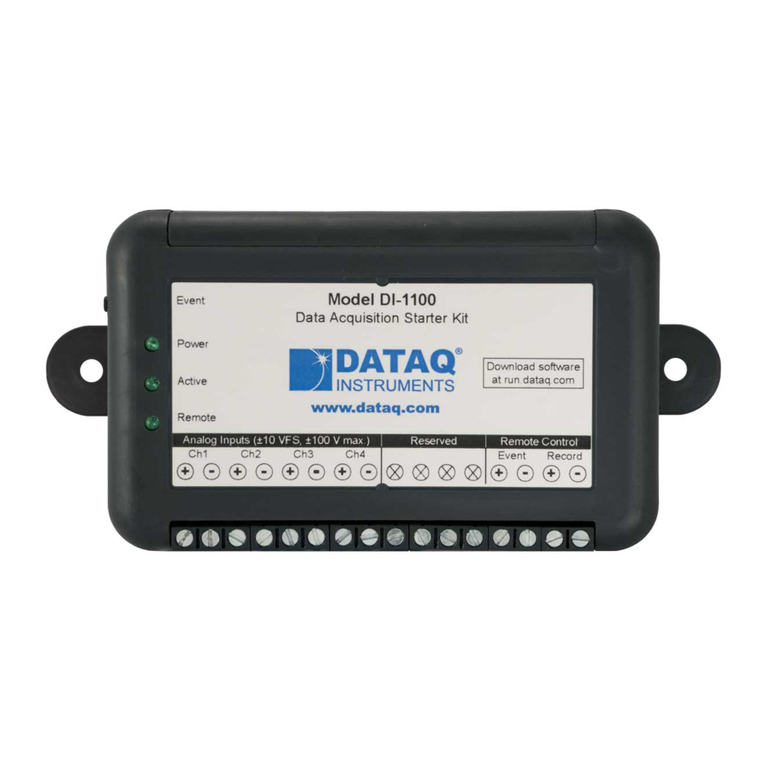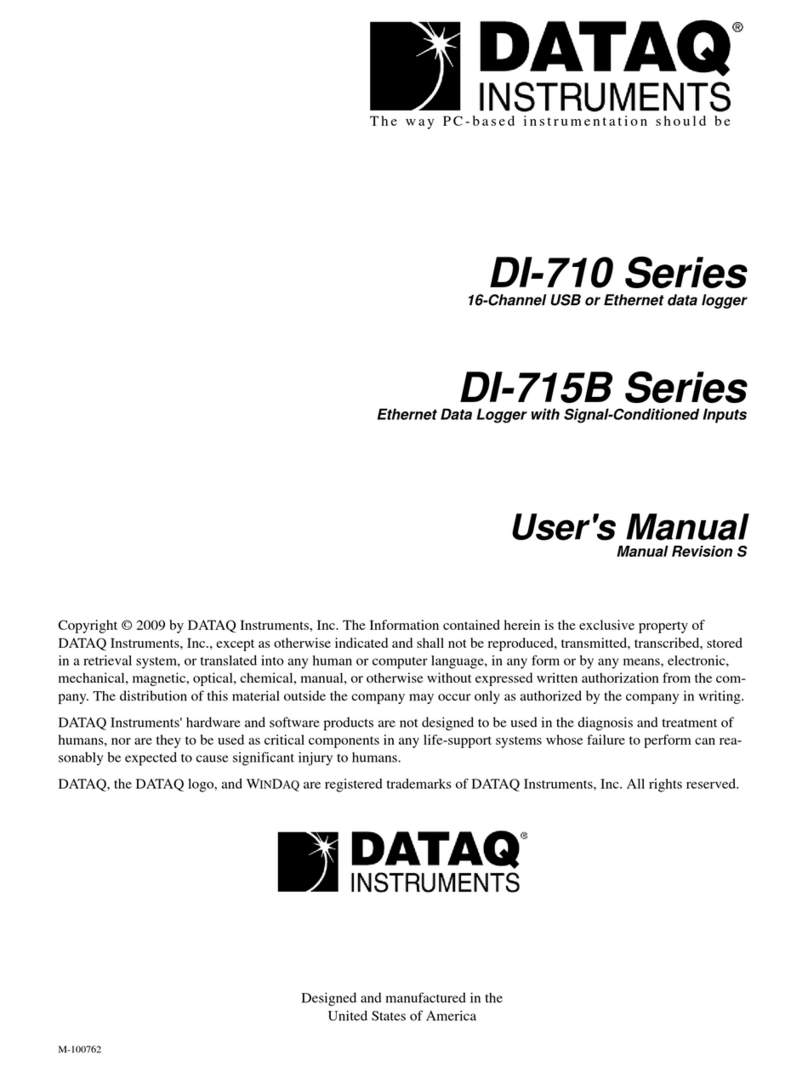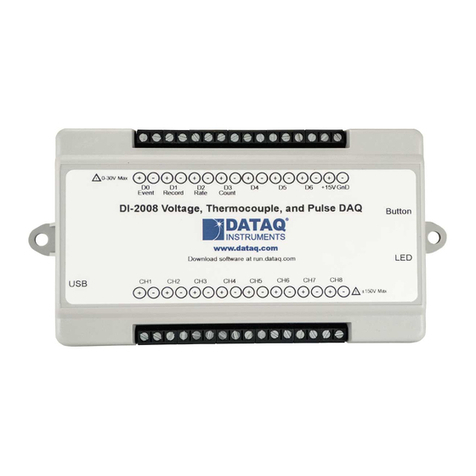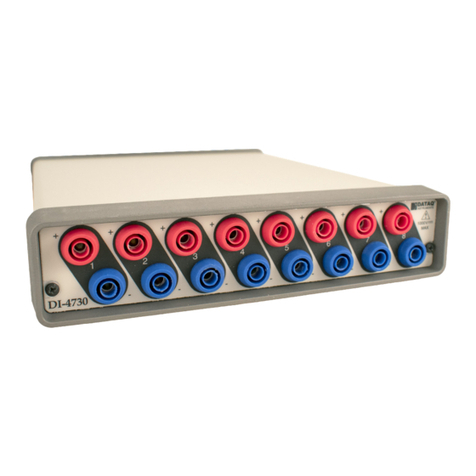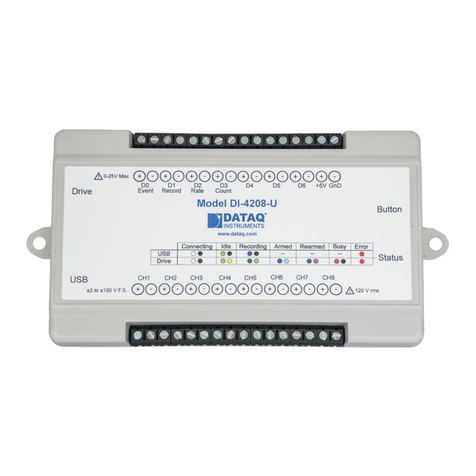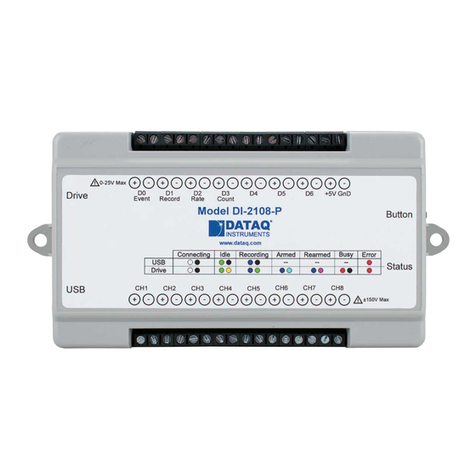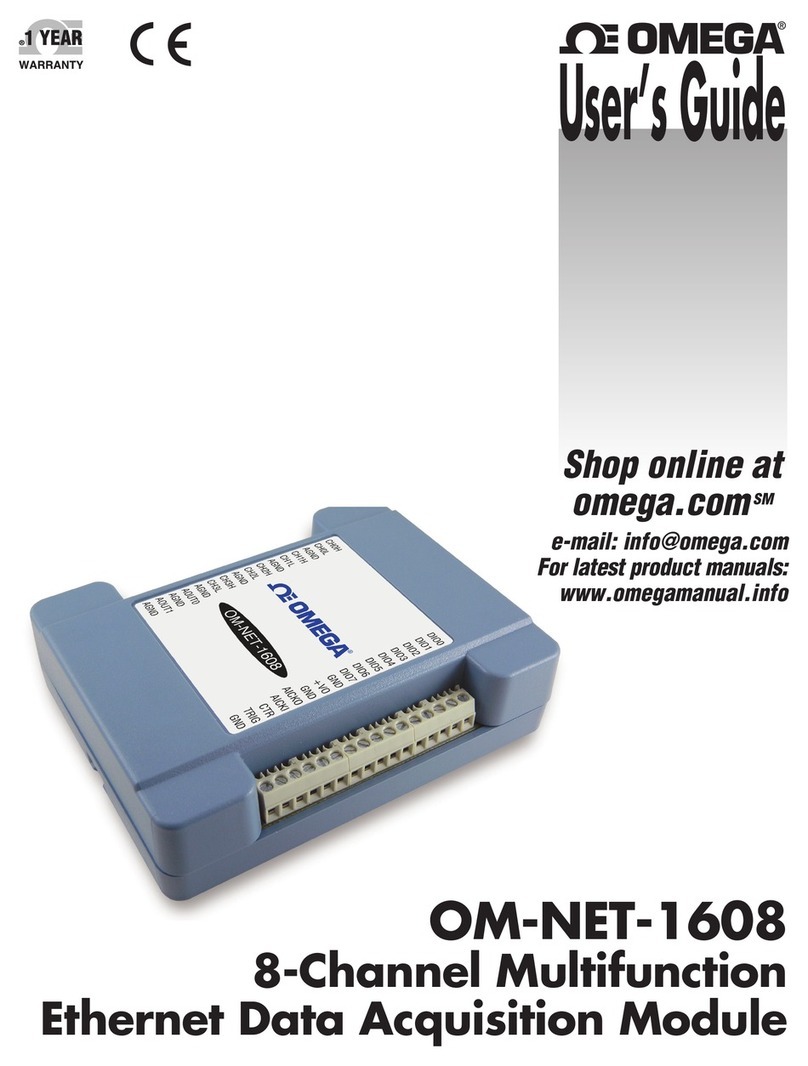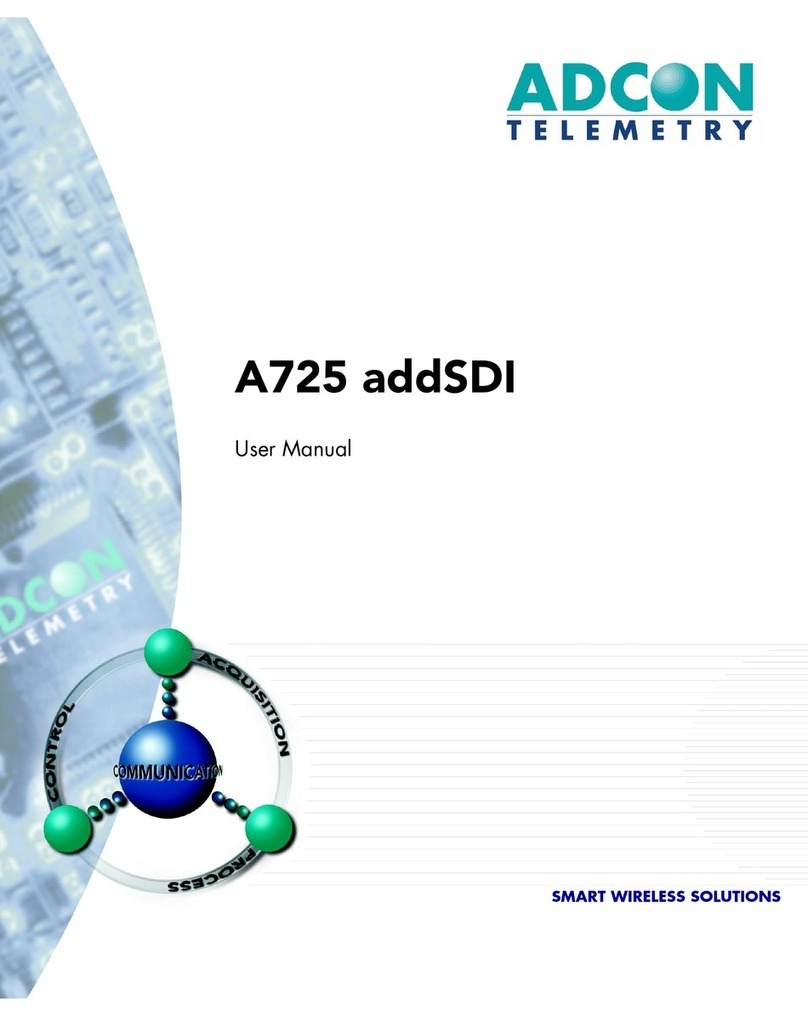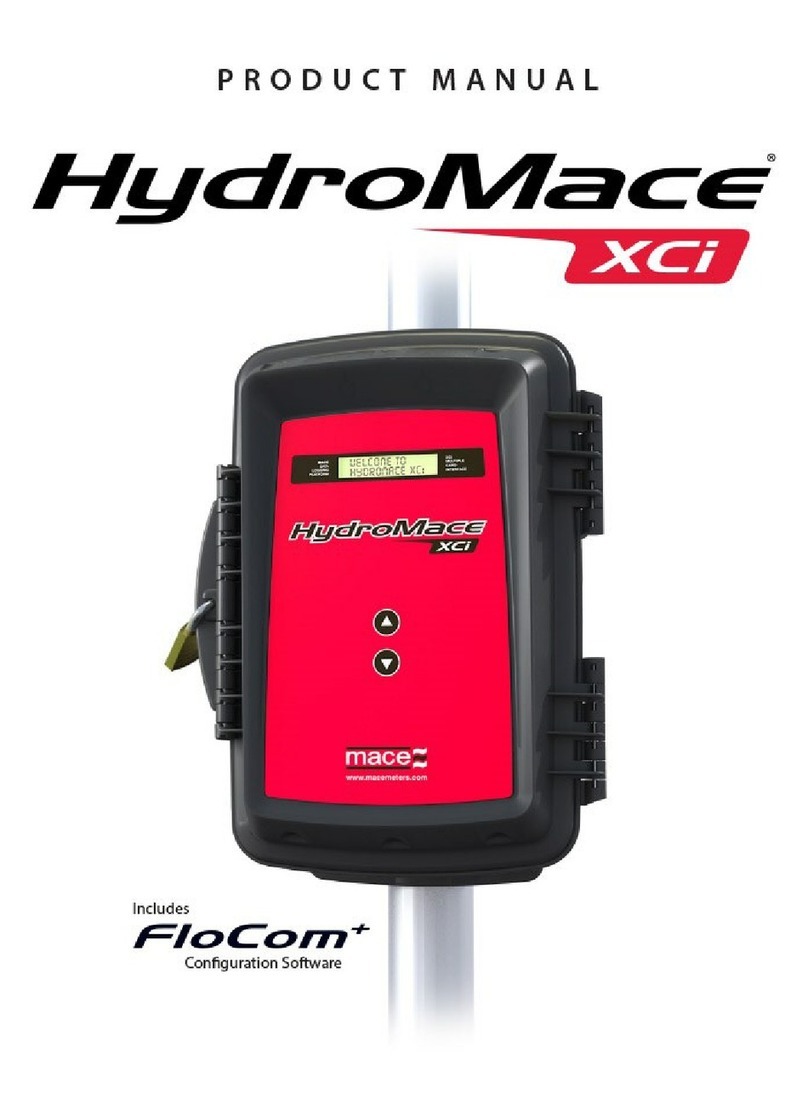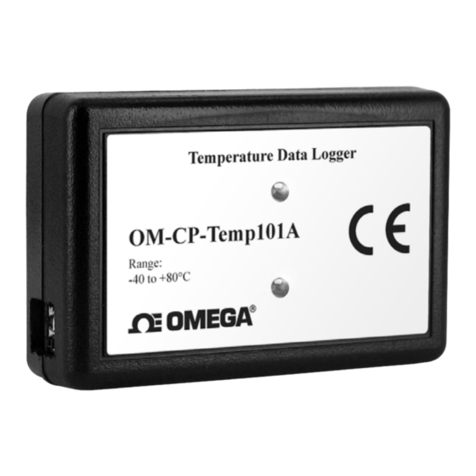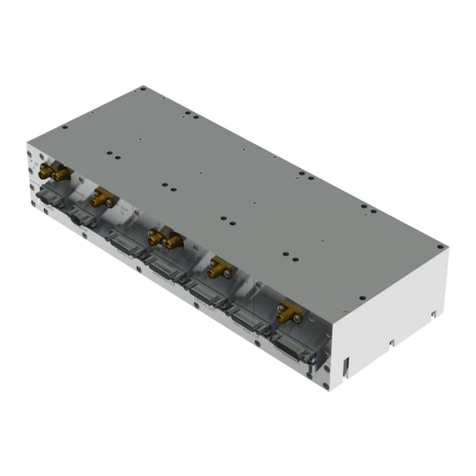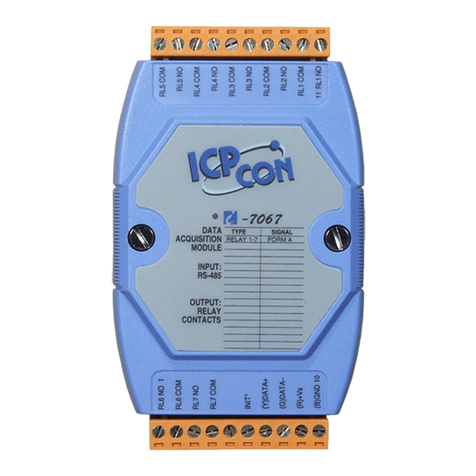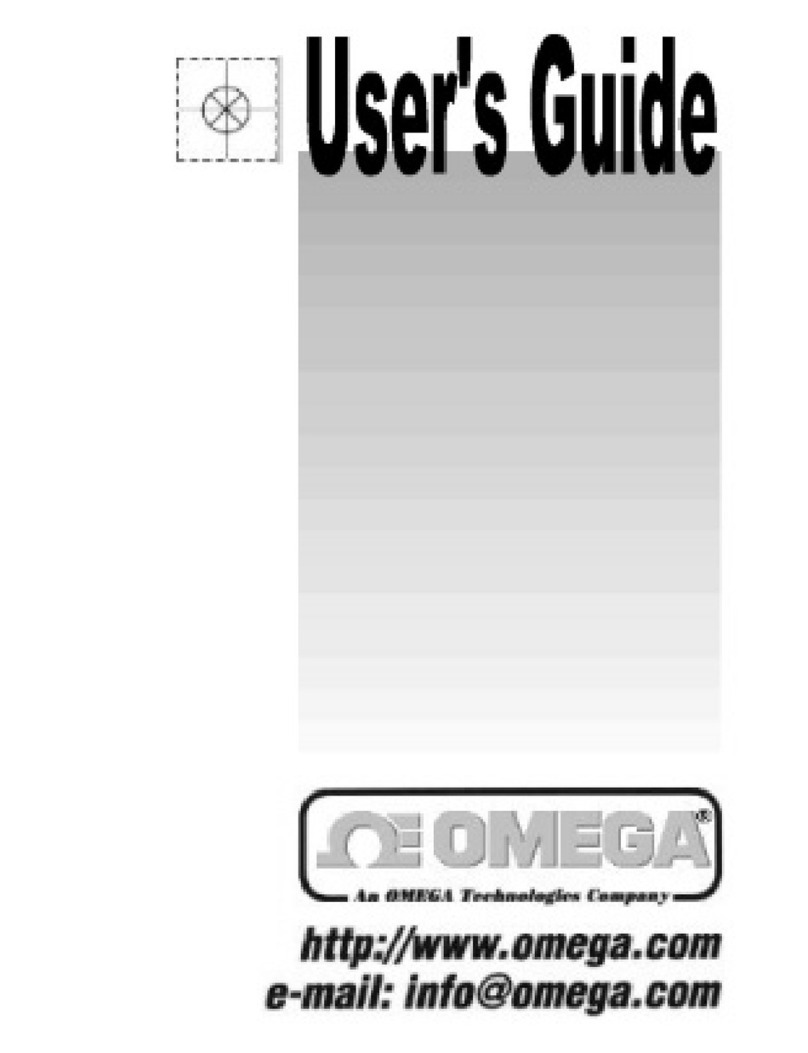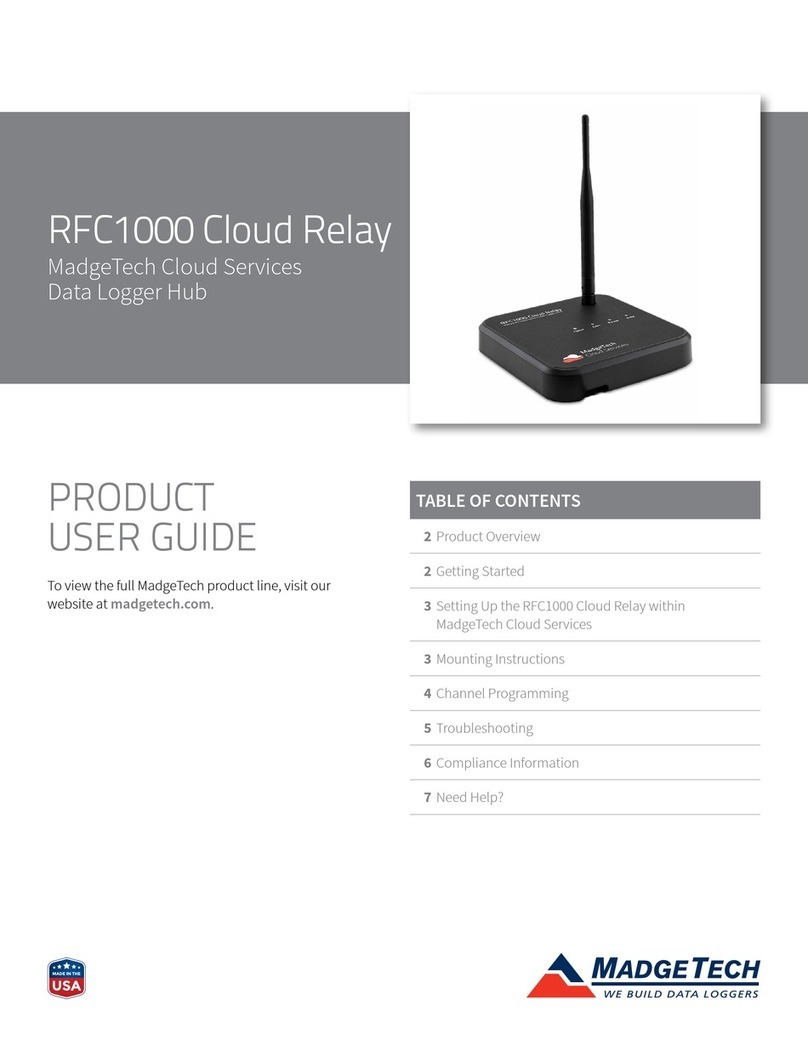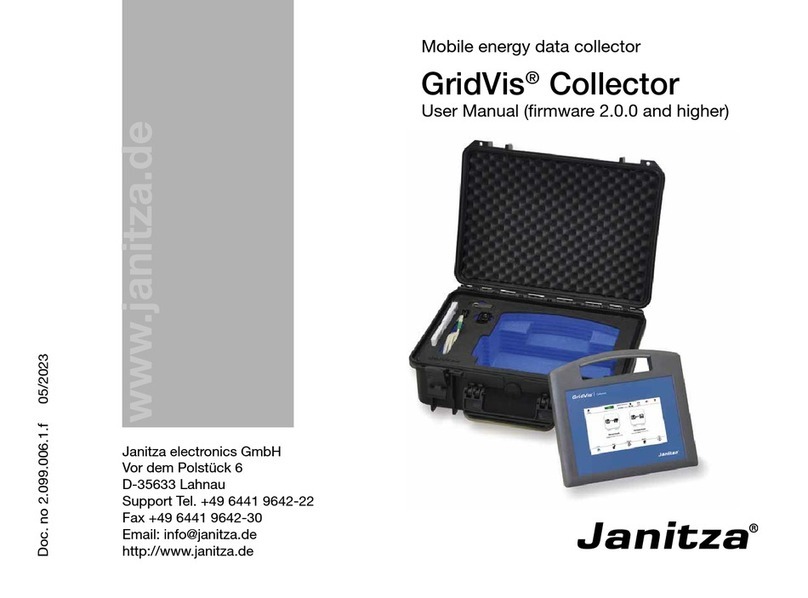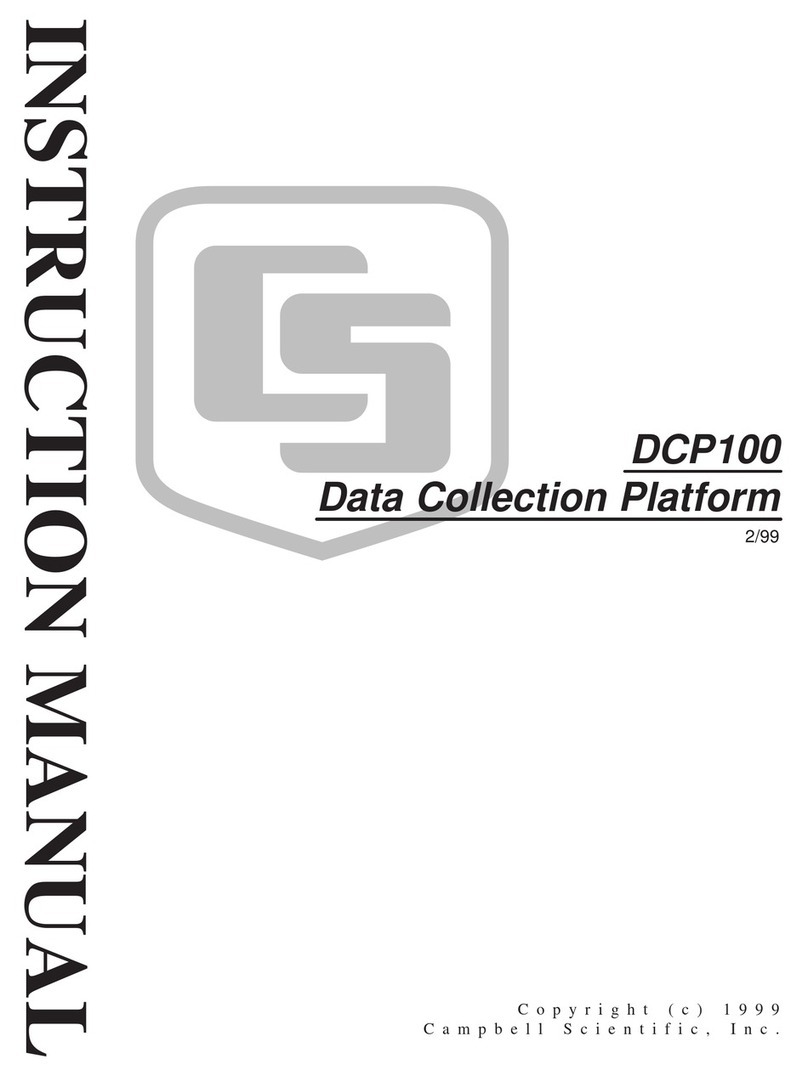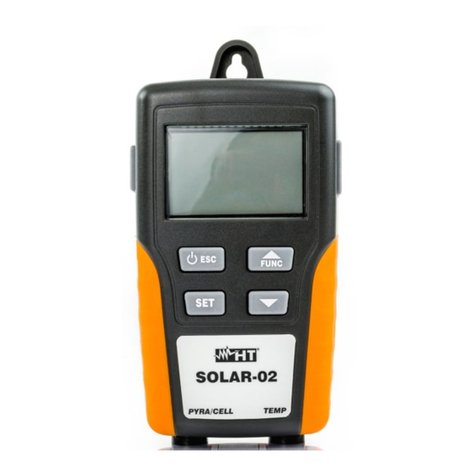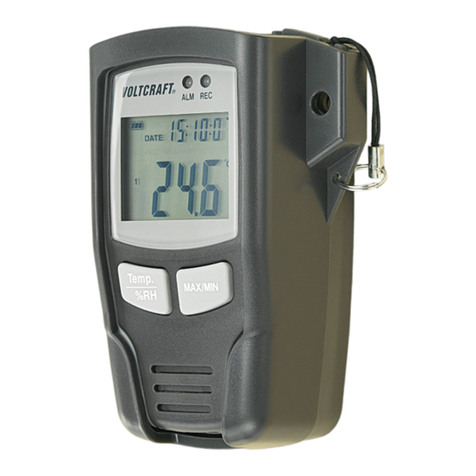Dataq DI-718B Series User manual

The way PC-based instrumentation should be
DI-718B Series
8 Channel Data Logger with Signal-Conditioned Inputs
DI-718Bx Series
16 Channel Data Logger with Signal-Conditioned Inputs
User's Manual
Manual Revision Y
Copyright © 2018 by DATAQ Instruments, Inc. The Information contained herein is the exclusive property of
DATAQ Instruments, Inc., except as otherwise indicated and shall not be reproduced, transmitted, transcribed, stored
in a retrieval system, or translated into any human or computer language, in any form or by any means, electronic,
mechanical, magnetic, optical, chemical, manual, or otherwise without expressed written authorization from the com-
pany. The distribution of this material outside the company may occur only as authorized by the company in writing.
DATAQ Instruments' hardware and software products are not designed to be used in the diagnosis and treatment of
humans, nor are they to be used as critical components in any life-support systems whose failure to perform can rea-
sonably be expected to cause significant injury to humans.
DATAQ, the DATAQ logo, and WINDAQ are registered trademarks of DATAQ Instruments, Inc. All rights reserved.
DATAQ Instruments, Inc.
241 Springside Drive
Akron, Ohio 44333 U.S.A.
Telephone: 330-668-1444
Fax: 330-666-5434
Designed and manufactured in the
United States of America
M-101018


Warranty and Service Policy
Product Warranty
DATAQ Instruments, Inc. warrants that this hardware will be free from defects in materials and workmanship under
normal use and service for a period of one year from the date of shipment. DATAQ Instruments' obligations under
this warranty shall not arise until the defective material is shipped freight prepaid to DATAQ Instruments. The only
responsibility of DATAQ Instruments under this warranty is to repair or replace, at its discretion and on a free of
charge basis, the defective material.
This warranty does not extend to products that have been repaired or altered by persons other than DATAQ Instru-
ments employees, or products that have been subjected to misuse, neglect, improper installation, or accident.
DATAQ Instruments shall have no liability for incidental or consequential damages of any kind arising out of the sale,
installation, or use of its products.
Service Policy
1. All products returned to DATAQ Instruments for service, regardless of warranty status, must be on a freight-pre-
paid basis.
2. DATAQ Instruments will repair or replace any defective product within 5 days of its receipt.
3. For in-warranty repairs, DATAQ Instruments will return repaired items to the buyer freight prepaid. Out of war-
ranty repairs will be returned with freight prepaid and added to the service invoice.


DI–718B and DI-718Bx Series Hardware Manual
Table of Contents
v
Table of Contents
Warranty and Service Policy ................................................................................................................ iii
1. Introduction ........................................................................................................................................ 1
Features .............................................................................................................................................. 1
Analog Inputs .................................................................................................................................... 1
Digital Inputs ..................................................................................................................................... 1
Software ............................................................................................................................................. 2
WinDaq® Recording and Playback Software ............................................................................ 2
The DATAQ Instruments Hardware Manager ............................................................................ 2
Help ............................................................................................................................................. 2
2. Specifications ...................................................................................................................................... 3
Analog Inputs .................................................................................................................................... 3
A/D Characteristics ............................................................................................................................ 3
Scanning Characteristics .................................................................................................................... 3
Digital I/O .......................................................................................................................................... 4
Calibration ......................................................................................................................................... 4
Ethernet Interface .............................................................................................................................. 4
USB Interface (DI-718B Models only) ............................................................................................. 4
Removable Memory (Stand-alone Models only) .............................................................................. 4
Real Time Clock ................................................................................................................................ 4
Controls (Stand-alone Models only) .................................................................................................. 4
Indicators ........................................................................................................................................... 4
Transfer Rate to PC ........................................................................................................................... 4
General ............................................................................................................................................... 5
3. Installation .......................................................................................................................................... 7
Unpacking .......................................................................................................................................... 7
USB Device Installation .................................................................................................................... 7
Ethernet Device Installation .............................................................................................................. 9
Installing an Ethernet Device Directly Connected to your PC or Connected via a Hub or Switch Where
ONLY DI-71x Products are Installed ................................................................................................ 10
Installing an Ethernet Device via a Distributed Network Without a DHCP Server .......................... 13
Installing an Ethernet Device via a Distributed Network with a DHCP Server ................................ 14
Activation of WinDaq/High Speed Option ....................................................................................... 14
Dataq Instruments Hardware Manager .............................................................................................. 14
4. Instrument Controls, Indicators, and Connections ........................................................................ 17
Instrument Front Panel ...................................................................................................................... 17
DI-718B Models ......................................................................................................................... 17
Built-In Remote Control Jack ............................................................................................... 17
DI-718Bx Models ....................................................................................................................... 18
Installing DI-8B Modules .................................................................................................................. 18
Installing DI-8B modules in DI-718B Instruments ..................................................................... 18
Installing DI-8B modules in DI-718Bx Instruments ................................................................... 19
Enabling CJC for Thermocouple Modules ........................................................................................ 21
Enabling CJC in DI-718B Instruments ....................................................................................... 21
Enabling CJC in DI-718Bx Instruments ..................................................................................... 22
Connecting Signals ............................................................................................................................ 23

DI–718B and DI-718Bx Series Hardware Manual
Table of Contents
vi
Instrument Rear Panel ........................................................................................................................ 24
DI-718B Rear Panel .................................................................................................................... 24
Power Input Jack .................................................................................................................. 24
Ground Lug ........................................................................................................................... 24
Interface Port ........................................................................................................................ 24
Control Button (Stand-alone models only) ........................................................................... 24
Mode LED Indicator ............................................................................................................. 24
Removable Storage (SD) Slot (Stand-alone models only) ................................................... 25
DI-718Bx Rear Panel .................................................................................................................. 25
Ground Lug ........................................................................................................................... 25
Ethernet Port ......................................................................................................................... 25
Control Button (Stand-alone models only) ........................................................................... 25
Mode LED Indicator ............................................................................................................. 25
Removable Storage (SD) Slot (Stand-alone models only) ................................................... 25
Digital I/O and Monitor Out ................................................................................................. 26
Power Input Jack .................................................................................................................. 26
Power Switch ........................................................................................................................ 26
Control Button Operations .......................................................................................................... 26
Start Recording ..................................................................................................................... 26
Stop Recording ..................................................................................................................... 26
Formatting the Memory Card ............................................................................................... 26
Reconfigure Instrument ........................................................................................................ 26
Fix Errors .............................................................................................................................. 27
Mode LED Indicator ................................................................................................................... 27
5. Operation ............................................................................................................................................ 29
Operation for PC-connected Models ................................................................................................. 29
Enabling/Disabling Digital Remote Control ............................................................................... 29
Analog Input Channel Configuration .......................................................................................... 29
Enabling Channels for DI-718B Instruments ....................................................................... 29
Enabling Channels for DI-718Bx Instruments ..................................................................... 30
EU Settings (DI-718B and DI-718Bx Instruments) ............................................................. 30
Operation for Stand-alone Models ..................................................................................................... 31
PC-connected operation .............................................................................................................. 31
Networked operation as a data acquisition server (DI-718B-ES and DI-718Bx-S models) ....... 31
Stand-alone data logger operation ............................................................................................... 32
The Stand-alone Set Up Panel .............................................................................................. 32
Operation .............................................................................................................................. 32
Troubleshooting .................................................................................................................... 33
If power down occurs unexpectedly while recording to SD ................................................ 34
WinDaq Waveform Browser for SD .................................................................................... 34
6. Block Diagram .................................................................................................................................... 37
DI-718B Models ................................................................................................................................ 37
DI-718Bx Models .............................................................................................................................. 38
7. Accessories .......................................................................................................................................... 39
DI-705 (for DI-718Bx models only) .................................................................................................. 39
DI-8B30/31 Analog Voltage Input Modules, 3Hz Bandwidth .......................................................... 40
DI-8B32 Analog Current Input Modules ........................................................................................... 41
DI-8B33 True RMS Input Modules ................................................................................................... 42
DI-8B34 Linearized 2- or 3-Wire RTD Input Modules ..................................................................... 43
DI-8B35 Linearized 4-Wire RTD Input Modules ............................................................................. 44

DI–718B and DI-718Bx Series Hardware Manual
Table of Contents
vii
DI-8B36 Potentiometer Input Modules ............................................................................................. 45
DI-8B38 Strain Gage Input Modules, Narrow & Wide Bandwidth .................................................. 46
DI-8B40/41 Analog Voltage Input Modules, 1kHz Bandwidth ........................................................ 47
DI-8B42 2-Wire Transmitter Interface Modules ............................................................................... 48
DI-8B43 DC LVDT Input Modules .................................................................................................. 49
DI-8B45 Frequency Input Modules ................................................................................................... 50
DI-8B47 Linearized Thermocouple Input Modules .......................................................................... 51
DI-8B50/51 Analog Voltage Input Modules, 20kHz Bandwidth ...................................................... 52


DI–718B and DI-718Bx Series Hardware Manual
Introduction
1
1. Introduction
Congratulations on your purchase of the DI-718B data logger/data acquisition system or DI-718Bx data logger/data
acquisition system. The DI-718B is designed specifically to accept DI-8B modules — the world’s smallest fully func-
tional isolated analog signal conditioner.
Features
Common features of the DI-718B and the DI-718Bx are:
• 4,800 Hz maximum sampling rate—14,400 Hz when in Stand-alone data logger operating mode.
• 0.048 Hz minimum sampling rate—0.0017 Hz when in Stand-alone data logger operating mode.
• 14-bit A/D converter for high resolution measurement accuracy.
• The Stand-alone option allows the user to configure a recording session through their PC then record data in
the field to an SD card (without being connected to their PC).
The DI-718B has the following additional features:
• Accepts up to 8 DI-8B amplifier modules accommodating virtually any industrial signal.
• USB or Ethernet interface options.
The DI-718Bx has the following additional features:
• Accepts up to 16 DI-8B amplifier modules accommodating virtually any industrial signal.
• Ethernet interface.
Analog Inputs
DI-718B models provide 8 fixed single-ended analog inputs that allow your analog signals to be converted into 14-bit
digital data via an on board A/D converter. Differential input is not supported.
DI-718Bx models provide 16 fixed single-ended analog inputs that allow your analog signals to be converted into 14-
bit digital data via an on board A/D converter. Differential input is not supported.
Digital Inputs
The DI-718B provides two digital input channels for Remote Control Operations (Remote Start/Stop and Remote
Events) that may be accessed using the Built-In Remote Control Jack (see "Built-In Remote Control Jack" on page
17). Remote Control configuration and setup is easily accessible in both WINDAQ Acquisition software and in the
Dataq Instruments Hardware Manager (when configuring the instrument for Stand-alone operation).
The DI-718Bx provides 8 software-programmable digital lines (bits) for input/output operations. These lines provide
an interface for the transfer of data between user memory and a peripheral device connected to the instrument. Digital
inputs can monitor alarms or sensors with TTL outputs, while digital outputs can drive TTL inputs on control or mea-
surement equipment. Remote control can be utilized with bits 0 and 1 and is easily accessed using WINDAQ Acquisi-
tion software or, for stand-alone models, in the stand-alone setup panel. To avoid using an analog input channel for
Digital I/O, Channel 17 may be enabled as the digital channel. To use the Remote Control features in WINDAQ Acqui-
sition software either Channel 1 or Channel 17 must be configured as the Digital Input channel. Access digital I/O
ports from the rear panel of the device. See "Digital I/O and Monitor Out" on page 26. Digital I/O bits are not avail-
able in Stand-alone mode except for Remote Control functions.

DI–718B and DI-718Bx Series Hardware Manual
Introduction
2
Software
All software required to record and playback waveforms is included with the purchase of any DI-718 model including
WINDAQ Acquisition and Playback software and the Dataq Instruments Hardware Manager.
WINDAQ®Recording and Playback Software
WINDAQ Acquisition and WINDAQ Waveform Browser allow you to record and playback data acquired through your
instrument. Whether using a Stand-alone model or a PC-connected instrument, WINDAQ is an invaluable resource for
analyzing data. A special version (see "WinDaq Waveform Browser for SD" on page 34) of WINDAQ Waveform
Browser (free) is required to read waveform data recorded to a Memory Card but is easily transferred to the standard
version for more analytical features.
WINDAQ Acquisition software can be used to record waveforms directly and continuously to disk while monitoring a
real time display of the waveforms on-screen. It operates and displays waveform signals in real time at the full sample
rate of the instrument being used. WINDAQ is free but is restricted to recording throughput rates of 1108 Hz with a
DI-718. An optional Unlock Code for high speed allows you to record data at the speed of your data acquisition sys-
tem. When you install the software, a trial version of High Speed is automatically installed allowing you to run the
software for a limited time. Activation is required for continued use to ensure compliance with the Software License
Agreement. This software is accessed through the Dataq Instruments Hardware Manager which can be found in the
Start menu under the WINDAQ program group called Dataq Instruments Hardware Manager.
WINDAQ Waveform Browser playback software (also known as “WWB”) offers an easy way to review and analyze
acquired waveforms. A built-in data file translator allows the user to display multiple waveforms acquired by
WINDAQ Acquisition software or any of a wide range of data acquisition packages. The software’s disk-streaming
design allows data files of any length to be graphically displayed rapidly, in normal or reverse time directions. Seven
standard cursor-based measurements, frequency domain, and statistical analysis functions help simplify waveform
analysis and interpretation. WINDAQ Waveform Browser is free and installed when installing WINDAQ Software.
The DATAQ Instruments Hardware Manager
The DATAQ Instruments Hardware Manager allows you to effectively manage and run multiple instruments installed
and connected to your PC or your Network—or even over the internet. This software can be found in the Start menu
under the WINDAQ program group called Dataq Instruments Hardware Manager. Access WINDAQ Acquisition
software, upload data from your memory card, check the status of your memory card, format your memory card, con-
figure a Stand-alone data acquisition session, and more in this easy-to-use point and click environment. View the
Help files by clicking on View Help in the Help menu or by pressing F1.
Help
All WINDAQ software utilizes context-sensitive help. Help may be accessed through the Help menu or by pressing the
F1 key with any feature selected. This will take you directly to the Help topic most relevant to that particular function
or feature. Help topics discuss in detail each function available in the software.

DI–718B and DI-718Bx Series Hardware Manual
Specifications
3
2. Specifications
Analog Inputs
Number of Channels: DI-718B: 8 configured for signal conditioned inputs
DI-718Bx: 16 configured for signal conditioned inputs
Channel Configuration: Defined by DI-8B Module
Input Impedance: Defined by DI-8B Module
Input offset voltage: Defined by DI-8B Module
Channel-to-Channel crosstalk rejection: -75db @ 100unbalance
Offset temperature coefficient: 0.25µV/°C
Digital Filtering: PC-connected models: Conditional over-sampling; peak/valley detect,
last point, average, frequency, RMS
Stand-alone models: None
Measurement Range: Defined by DI-8B module on a channel-by-channel basis.
Note: Not all DI-8B amplifier modules support ± excitation, but all
support ± channel inputs.
Accuracy: DI-718B: ±0.25%FSR (1800 S/s, averaging mode)
DI-718Bx: ±.05%FSR ±50µV + 8B module + CJC error (test condi-
tions: 1 channel; 100 S/s; averaging mode)
Resolution: ±1 part in 8,192
Gain (DI-718Bx only): 1, 2, 4, 8 software selectable per channel.
CJC Error: ±1.5°C plus 8B Module (spec measured at 25°C with no air circulation
and Low Current Module configuration only).
A/D Characteristics
Type: Successive Approximation
Resolution: 14-bit
Monotonicity: ±2 LSB
Conversion Time: 69.4µs
Scanning Characteristics
Maximum sample throughput rate: PC-connected: 4,800 Hz
Stand-alone: 14,400 Hz*
*Dependent on SD card used. Low speed SD cards can sample up to 2,000
Hz; High speed cards can sample up to 14,400 Hz. Some high speed cards
cannot sample as high at 14,400 Hz but their capability can only be deter-
mined by trial and error (Model 101014-2G has been tested and approved).
Minimum sample throughput rate: PC-connected: 0.0034 Hz; Stand-alone: 0.0017 Hz
Maximum scan list size: DI-718B: 9 entries; DI-718Bx: 18 entries
Sample buffer size: 2kb

DI–718B and DI-718Bx Series Hardware Manual
Specifications
4
Digital I/O
Bits: DI-718B: 2 Inputs (Remote Storage and Remote Event)
DI-718Bx: 8 bi-directional (including Remote Storage/Event)
Input voltage levels: Min. required “1” 2V; Max allowed “0” 0.8V
Calibration
Calibration Cycle: One year
Ethernet Interface
Type: 10/100Base-T
Connector: RJ-45
Protocol: TCP/IP
Server Type: DHCP
USB Interface (DI-718B Models only)
Connector: USB
Protocol: USB 2.0
Removable Memory (Stand-alone Models only)
Type: Standard Secure Digital (not SDHDor SDxC). Sample rates of 2kHz
require SD speeds of 133x or higher. Up to 2kHz require speeds of 13x or
higher.
Capacity: 16MB to 2GB
Real Time Clock
Type: Date, hour, minute, second
Resolution: 1 second
Accuracy: 20 ppm
Controls (Stand-alone Models only)
Single push-button: Provides manual control over Record and Standby modes.
Indicators
Stand-alone models: Three color LED indicating Record, Standby, and Error conditions.
PC-connected models: Power LED
Transfer Rate to PC
Real Time: up to 4,800 samples per second
From SD Memory (Ethernet): up to 3,000 samples per second

DI–718B and DI-718Bx Series Hardware Manual
Specifications
5
General
Panel Indicators: Mode LED
Panel Controls: Control push-button (Stand-alone models)
Panel slots: Accepts SD-type flash memory
Input connectors: DI-718B: Two, removable sixteen position terminal blocks
DI-781BX: Four, removable sixteen position terminal blocks for signal-
conditioned channels.
Operating Environment: 0°C to 70°C
Enclosure: Aluminum base with steel wrap-around. Aluminum end-panels with plastic
bezels. Aluminum top hatch for access to 8B backplane.
Dimensions: DI-718B: 5.4D × 4.1W × 1.5H in. (13.81D × 10.48W × 3.81H cm.)
DI-718Bx: 7.29W × 9L × 1.52H in. (18.52W × 22.86L × 3.86H cm.)
Weight: DI-718B: 14 oz. (397 grams) + DI-8B Modules
DI-718Bx: 2 lbs. 10 oz. (1.19 kg) + DI-8B Modules
Power Requirements: USB: 9 to 36 VDC, 2 watts + 8B modules
Ethernet: 9 to 36 VDC, 2.5 watts + 8B modules


DI–718B and DI-718Bx Series Hardware Manual
Installation
7
3. Installation
Unpacking
The following items are included with each instrument. Verify that you have the following:
• DI-718B or DI-718Bx Series Instrument.
• DI-8B Module(s) as ordered.
• Communications cable (USB only - Ethernet models do not come with an Ethernet cable).
• Power cable.
• Jumpers to enable CJC (DI-718B only — jumpers for the DI-718Bx are located on the circuit board).
• Two (or four) removable 16 position screw terminal blocks.
• DI-718B models include a 3.5mm stereo phone plug for Remote Control Operations (“Built-In Remote Con-
trol Jack” on page 17).
• The WINDAQ Resource CD-ROM.
• DATAQ screwdriver for connecting signal leads to the screw terminal(s).
• This Hardware Manual.
If an item is missing or damaged, call DATAQ Instruments at 330-668-1444. We will guide you through the appropri-
ate steps for replacing missing or damaged items. Save the original packing material in the unlikely event that your
unit must, for any reason, be sent back to DATAQ Instruments.
USB Device Installation
1. Disconnect all DATAQ Instruments USB devices from your Computer.

DI–718B and DI-718Bx Series Hardware Manual
Installation
8
2. Insert the WINDAQ Resource CD in your drive. The installation software should start automatically within 20 sec-
onds. If it does not, start it manually by double-clicking the Setup application (setup.exe) located on the root of
the WINDAQ Resource CD.
3. In the “What do you want to do?” window, select “Install WinDaq Software” and click OK.
4. In the “Installing Software” window, select the “Install Software for DI-148, DI-158, DI-710, DI-715B, and DI-
718B(x) instruments” option and click OK.
5. In the “WinDaq Installation” dialog box, select the “Install Software” option and click OK to continue. If you
wish to view the hardware documentation you may do so now by clicking on the appropriate radio button. Docu-
mentation will be saved to your hard drive during this installation.
6. In the “Welcome!” box, click OK to continue.
7. Read the License Agreement. If you accept the terms, click Accept and Continue. If you choose not to accept,
click on the Do not accept and stop button to end the installation.
8. When prompted, enter your registration information (name and company) in the appropriate text boxes and click
OK. Confirm your registration information before continuing.
9. When prompted, specify the directory where you want to install your WINDAQ software. It is recommended that
you accept the default. If you have already successfully installed a DI-148, DI-158, DI-710, DI-715B, or DI-
718B instrument be sure to install to the same folder.
10. In the “Select an Interface” box select USB and click OK.
11. DO NOT connect your USB device or cable to your PC until installation is complete. If your device is currently
connected, please disconnect it before continuing with this installation. Once your device is disconnected, click
the OK button.
12. When prompted to Select a Program Manager Group specify a destination (or group window) in the Start Menu
for WINDAQ software icons. It is recommended that you accept the default.
13. In the “Installation Option” dialog box specify whether you want all users to have access to WINDAQ software or
just the current User. Click Yes to allow all users to have access, click No to allow just the current user to have
access.
14. After WINDAQ Software installs, you will be prompted to install WINDAQ/XL Trial Version and Advanced
CODAS Analysis software. If you wish to install either software click on Yes in the appropriate dialog box. Fol-
low the on screen prompts to complete installation.
15. Software installation is complete - you will now see a “Successful Installation” box - click OK to exit WINDAQ
Installation.
You can now plug the device(s) into your PC and apply power (if required). You do not need to re-install this software
when installing more DI- 71x USB devices to your PC.
Click on the appropriate program group (specified above — default is Start > Programs > WINDAQ) and click on
“DATAQ Instruments Hardware Manager” to run WINDAQ software. All DATAQ Instruments software is located in
the same program group.

DI–718B and DI-718Bx Series Hardware Manual
Installation
9
Ethernet Device Installation
Install WINDAQ Software and the DATAQ Instruments Hardware Manager.
1. Insert the WINDAQ Resource CD in your drive. The installation software should start automatically within 20 sec-
onds. If it does not, start it manually by double-clicking the Setup application (setup.exe) located on the root of
the WINDAQ Resource CD.
2. In the “What do you want to do?” window, select “Install Software” and click OK.
3. In the “Installing Software” window, select the “Install Software for DI-148, DI-158, DI-710, DI-715B, and DI-
718B(x) instruments” option and click OK.
4. In the “WinDaq Installation” dialog box, select the “Install Software” option and click OK to continue. If you
wish to view the full hardware documentation you may do so now by clicking on the appropriate radio button.
Documentation will be saved to your hard drive during installation.
5. In the “Welcome!” box, click OK to continue.
6. Read the License Agreement. If you accept the terms, click Accept and Continue. If you choose not to accept,
click on the Do not accept and stop button to end the installation.
7. When prompted, enter your registration information (name and company) in the appropriate text boxes and click
OK. Confirm your registration information before continuing.
8. When prompted, specify the directory where you want to install your WINDAQ software. It is recommended that
you accept the default. If you have already successfully installed a DI-148, DI-158, DI-710, DI-715B, or DI-
718B instrument be sure to install to the same folder.
9. In the “Select an Interface” box select the Ethernet option and click OK to continue.
10. When prompted to Select a Program Manager Group specify a destination (or group window) in the Start Menu
for WINDAQ software icons. It is recommended that you accept the default.
11. In the “Installation Option” dialog box specify whether you want all users to have access to WINDAQ software or
just the current User. Click Ye s to allow all users to have access, click No to allow just the current user to have
access.
12. After WINDAQ Software installs, you will be prompted to install WINDAQ/XL Trial Version and Advanced
CODAS Analysis software. If you wish to install either software click on Ye s in the appropriate dialog box. Fol-
low the on screen prompts to complete installation.
13. Installation is complete - you will now see a “Successful Installation” box - click OK to exit WINDAQ Installa-
tion.
Ethernet devices can now be connected to your network or PC. Follow the appropriate instructions in “Installing an
Ethernet Device Directly Connected to your PC or Connected via a Hub or Switch Where ONLY DI-71x Products are
Installed” on page 10 “Installing an Ethernet Device via a Distributed Network Without a DHCP Server” on page 13,
or “Installing an Ethernet Device via a Distributed Network with a DHCP Server” on page 14 of this manual for your
specific network connections configuration.
Click on the appropriate program group (specified above — default is Start > Programs > WINDAQ) and click on
“DATAQ Instruments Hardware Manager” to run WINDAQ software. All DATAQ Instruments software is located in
the same program group.

DI–718B and DI-718Bx Series Hardware Manual
Installation
10
Installing an Ethernet Device Directly Connected to your PC or Connected
via a Hub or Switch Where ONLY DI-71x Products are Installed
Installation of an Ethernet device directly connected to the network card on your computer requires you to change the
IP address of your network card.
Note: When installing an Ethernet device directly connected to your PC you MUST use a crossover cable (provided).
Installation of an Ethernet device via an Ethernet hub/switch containing ONLY DI-71x products also requires you to
change the IP address of your network card.
Note: For hubs that do not have an auto-switching sensor (usually older hubs) you must not use a crossover cable.
1. Install software (see “Ethernet Device Installation” on page 9).
1. Find the Network Connections on your computer (usually in the Control Panel).
2. Double-click on the Local Area Connection icon.
3. Click on the Properties button.

DI–718B and DI-718Bx Series Hardware Manual
Installation
11
4. Select Internet Protocol (TCP/IP) in the “This connection uses the following items” window and click on the
Properties button.
5. Click on the General tab.
6. Select the radio button Use the following IP address.
7. Enter 169.254.0.1 in the space provided for the IP address.

DI–718B and DI-718Bx Series Hardware Manual
Installation
12
8. Enter 255.255.0.0 in the space provided for the Subnet mask.
9. Click on the OK button to close the Internet Protocol (TCP/IP) Properties dialog box then click on the OK but-
ton in the Local Area Connection Properties dialog box for the changes to take effect.
10. You will now be able to see the device in the DATAQ Instruments Hardware Manager (you may have to click on
the Update List button).
This manual suits for next models
4
Table of contents
Other Dataq Data Logger manuals
